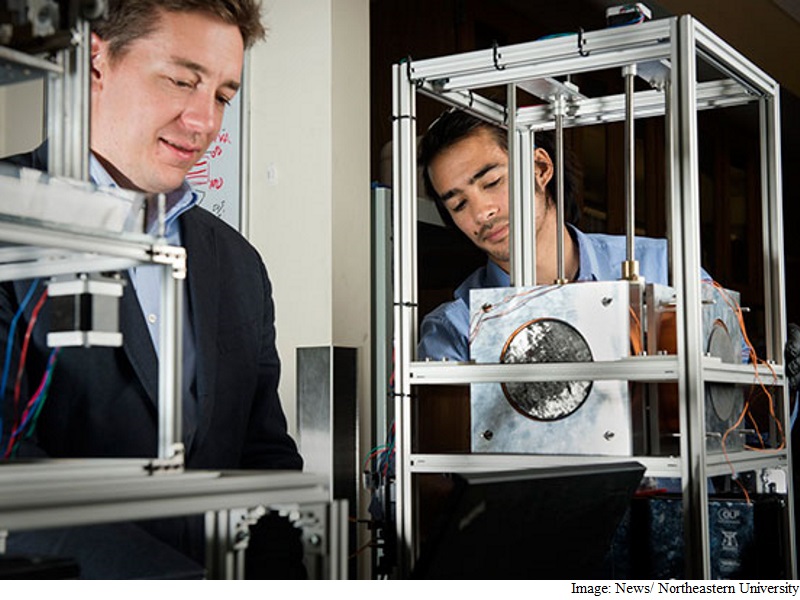- Home
- Science
- Science News
- New Method to 3D Print Customised Medical Devices Developed
New Method to 3D Print Customised Medical Devices Developed

The biomedical devices they are developing will be both stronger and lighter than current models and, with their customised design, ensure an appropriate fit.
One specific application of this new technology is developing patient-specific catheters, especially for premature newborns.
"With neonatal care, each baby is a different size, each baby has a different set of problems," said lead researcher Randall Erb, assistant professor at Northeastern University in US.
"If you can print a catheter whose geometry is specific to the individual patient, you can insert it up to a certain critical spot, you can avoid puncturing veins, and you can expedite delivery of the contents," said Erb.
The new technology enables researchers to control how the ceramic fibres are arranged - and hence control the mechanical properties of the material itself, the researchers said.
That control is critical if you are crafting devices with complex architectures, such as customised miniature biomedical devices.
Within a single patient-specific device, the corners, the curves, and the holes must all be reinforced by ceramic fibres arranged in just the right configuration to make the device durable.
This is the strategy taken by many natural composites from bones to trees.
"We are following nature's lead by taking really simple building blocks but organising them in a fashion that results in really impressive mechanical properties," said Joshua Martin, a doctoral candidate at Northeastern University.
Using magnets, Erb and Martin's 3D printing method aligns each minuscule fibre in the direction that conforms precisely to the geometry of the item being printed.
The magnets are the defining ingredient in their 3D printing technology.
First the researchers "magnetise" the ceramic fibres by dusting them very lightly with iron oxide, which, Martin notes, has already been approved by US Food and Drug Administration (FDA) for drug-delivery applications.
They then apply ultralow magnetic fields to individual sections of the composite material - the ceramic fibres immersed in liquid plastic - to align the fibres according to the exacting specifications dictated by the product they are printing.
Finally, in a process called "stereolithography," they build the product, layer by layer, using a computer-controlled laser beam that hardens the plastic. Each six-by-six inch layer takes a mere minute to complete.
The study was published in the journal Nature Communications.
Get your daily dose of tech news, reviews, and insights, in under 80 characters on Gadgets 360 Turbo. Connect with fellow tech lovers on our Forum. Follow us on X, Facebook, WhatsApp, Threads and Google News for instant updates. Catch all the action on our YouTube channel.
Related Stories
- Samsung Galaxy Unpacked 2025
- ChatGPT
- Redmi Note 14 Pro+
- iPhone 16
- Apple Vision Pro
- Oneplus 12
- OnePlus Nord CE 3 Lite 5G
- iPhone 13
- Xiaomi 14 Pro
- Oppo Find N3
- Tecno Spark Go (2023)
- Realme V30
- Best Phones Under 25000
- Samsung Galaxy S24 Series
- Cryptocurrency
- iQoo 12
- Samsung Galaxy S24 Ultra
- Giottus
- Samsung Galaxy Z Flip 5
- Apple 'Scary Fast'
- Housefull 5
- GoPro Hero 12 Black Review
- Invincible Season 2
- JioGlass
- HD Ready TV
- Laptop Under 50000
- Smartwatch Under 10000
- Latest Mobile Phones
- Compare Phones
- Realme P4x 5G
- OnePlus Ace 6T
- OPPO A6x 5G
- Samsung Galaxy Z TriFold
- Poco F8 Ultra
- Poco F8 Pro
- Huawei Mate 80 RS Master Edition
- Huawei Mate 80 Pro Max
- Asus ProArt P16
- MacBook Pro 14-inch (M5, 2025)
- Poco Pad M1
- Poco Pad X1
- Just Corseca Skywatch Pro
- Honor Watch X5
- Acerpure Nitro Z Series 100-inch QLED TV
- Samsung 43 Inch LED Ultra HD (4K) Smart TV (UA43UE81AFULXL)
- Asus ROG Ally
- Nintendo Switch Lite
- Haier 1.6 Ton 5 Star Inverter Split AC (HSU19G-MZAID5BN-INV)
- Haier 1.6 Ton 5 Star Inverter Split AC (HSU19G-MZAIM5BN-INV)

















